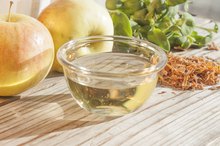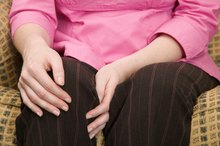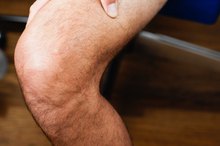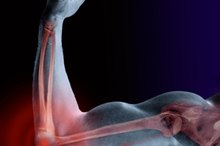How to Treat Water on the Elbow
Water on the elbow, which is also called elbow bursitis or olecranon bursitis, may be caused by trauma, infection, prolonged pressure on the elbow or conditions such as rheumatoid arthritis and gout. Inflammation of the bursa, a slippery sac located at the elbow tip that enables the skin on the elbow to move freely over the bone, causes symptoms such as pain and swelling. If infection is present, redness, fever, warmth and swollen lymph nodes may also be present.
If you are experiencing serious medical symptoms, seek emergency treatment immediately.
Visit your doctor for x-rays to rule out a bone spur or the presence of a foreign body. According to the American Academy of Orthopaedic Surgeons, bone spurs are common in patients with recurrent elbow bursitis 12.
What Causes Fluid on Your Knee?
Learn More
Have your joint aspirated to check for infection. Aspiration involves inserting a needle into the affected elbow joint to remove fluid. The fluid can then be sent to a laboratory and tested for bacteria.
Take antibiotics to treat water on the elbow if your symptoms are caused by a bacterial infection. Antibiotics may be prescribed before the specific bacterium is determined to prevent the infection from worsening.
What Causes Fluid on the Elbow?
Learn More
Elevate your elbow to reduce swelling and inflammation. You can prop your elbow up on pillows while watching television or sleeping. Ideally, the elbow should be raised to a position higher than your chest.
Apply ice to ease discomfort and help with swelling and inflammation. Some doctors recommend alternating ice with heat. You can purchase ice packs and heating pads for this purpose at most pharmacies.
Take over-the-counter non-steroidal anti-inflammatory medications, such as ibuprofen or naproxen. These medications will reduce inflammation and alleviate your pain. If your pain is not controlled through over-the-counter medications, ask your doctor for a prescription-strength pain reliever.
Avoid using your elbow as much as possible until recovery is complete and do not rest your weight on your elbow or apply pressure directly to the joint.
Agree to corticosteroid injections. Your doctor may drain fluid from the affected joint and then inject corticosteroid medications directly into the inflamed area. Pain and inflammation should improve greatly within hours of receiving the injection.
Undergo surgery to treat water on the elbow if antibiotics and other treatment options have failed. Your surgery may be done on an inpatient or outpatient basis, depending on the type of procedure performed and the anesthesia used. Most surgical procedures for elbow bursitis involve either surgical drainage of the bursa or removal of the bursa sac.
Attend physical rehabilitation sessions if your bursitis recurs frequently or fails to improve following surgery. An occupational or physical therapist will work with you to determine if you are misusing your elbow joint and will offer tips to reduce repetitive motions and prevent further episodes of water on the elbow.
Related Articles
References
- American Academy of Orthopaedic Surgeons
- American Academy of Family Physicians
- Taylor SA, Hannafin JA. Evaluation and Management of Elbow Tendinopathy. Sports Health. 2012;4(5):384-393. doi:10.1177/1941738112454651
- Khodaee M. Common Superficial Bursitis. Am Fam Physician. 2017;95(4):224-231.
- Hubbard MJ, Hildebrand BA, Battafarano MM, Battafarano DF. Common Soft Tissue Musculoskeletal Pain Disorders. Prim Care. 2018;45(2):289-303. doi:10.1016/j.pop.2018.02.006
- Bracilovic A. Septic Bursitis. Veritas Health, LLC. Updated November 21, 2019.
- Blackwell JR, Hay BA, Bolt AM, Hay SM. Olecranon bursitis: a systematic overview. Shoulder Elbow. 2014;6(3):182-190. doi:10.1177/1758573214532787
- InformedHealth.org. Bursitis: Overview. Cologne, Germany: Institute for Quality and Efficiency in Health Care (IQWiG); 2006.
- InformedHealth.org. How can bursitis be treated? Cologne, Germany: Institute for Quality and Efficiency in Health Care (IQWiG); 2006.
- Patel J, Girishkumar, Mruthyunjaya, Rupakumar CS. Bilateral Olecranon Bursitis - A Rare Clinical presentation of Calcium Pyrophosphate Crystal Deposition Disease. J Orthop Case Rep. 2014;4(1):3-6. doi:10.13107/jocr.2250-0685.137
- Lockman L. Treating nonseptic olecranon bursitis: a 3-step technique. Can Fam Physician. 2010;56(11):1157.
- Sayegh ET, Strauch RJ. Treatment of olecranon bursitis: a systematic review. Arch Orthop Trauma Surg. 2014;134(11):1517-1536.
- Aaron DL, et al. "Four Common Types of Bursitis: Diagnosis and Management." J Am Acad Orthop Surg June 2011; 19:359-367.
Writer Bio
Sandra Ketcham has nearly two decades of experience writing and editing for major websites and magazines. Her work appears in numerous web and print publications, including "The Atlanta Journal-Constitution," "The Tampa Bay Times," Visit Florida, "USA Today," AOL's Gadling and "Kraze Magazine."







